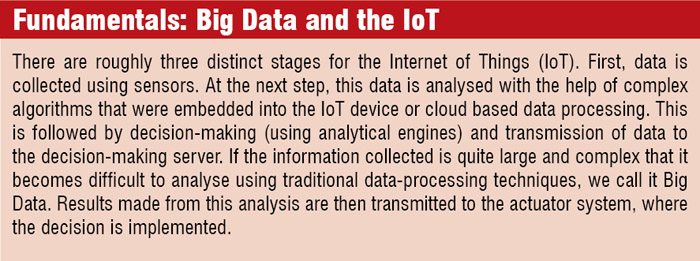Dilin Anand and Anagha P
Branded as the most over-hyped technology by Garner’s hype cycle report, the Internet of Things (IoT) has seen a large number of technologies being built to harness the symbiotic relationship between data from the IoT and analytics of Big Data.
The important thing to understand about the IoT is that, it is not just about reporting if lights are on in your parked car or to switch off your TV because you forgot to turn it off while leaving home. The real magic is in that, it can figure out potential situations that are about to happen and then go ahead and implement preventive measures before the problem actually occurs. The IoT in its full potential is about literally changing the future.
Of course, that is nowhere near easy because someone needs to set about…
… Tackling the chaos of things
Amit Shah of Mformation believes that, from a technology point of view, anybody who can manage chaos is going to succeed. Most commonly, we see that a single system contains different discrete machines talking in different protocols like Zigbee, Bluetooth or Wi-Fi. So, there is a lot of chaos in this franchise, making it very difficult for somebody off-stream to work with that chaos.
Nowadays, you find many individuals and firms trying to figure out how to collate and analyse inputs and derive a pattern that lets them make sense of this treasure trove of data. The challenge here is to understand how to federate it, that is, how integration takes place.
Machine-to-machine device management service providers look at figuring out which among these enormous data are useful and how to segregate it into consumable chunks that can be sold to different organisations or enterprises. The approach they take is to develop an adaptation for each of these machines that communicate in different languages, and hence shield that chaos from the consumer, using an intelligent gateway that presents a unified, sensible view.
There are many institutes, companies and ventures that have been set-up to crack this. University of Nottingham is one such example that recently received a £ 359,000 funding from the UK’s innovation agency for its value enhancement for data from assets & transactions (VEDAT) project. The objective of this project is to identify value from high volumes of complex data generated in real-time, through telematics technology—value that can be unlocked by other organisations for various fields like transportation, automation and medicine, to name a few.
Let us take a look at the different sectors that the IoT and Big Data have had an effect on.
… Enabling intelligent manufacturing
Manufacturers using the IoT is nothing new. Semiconductor firm Fujitsu grows their Kirei Yasai lettuce in a facility previously used to fabricate microchips. These lettuce do not just enjoy growing-up in a super-clean location, these are farmed by data-driven agricultural technology, powered by sensor arrays working in tandem with cloud-computing solutions to crunch data and ensure that the environment remains at optimal levels throughout the growth process. This includes monitoring temperature, humidity and fertiliser composition as they try to figure out the best growing conditions and ways to control micro-organisms.
Projects like these use solutions like Akisai, a food and agricultural cloud solution that leverages information and communications technology (ICT) to dramatically improve the efficiency of agricultural operations. Akisai will be used to continually analyse agricultural data for highly-productive cultivation and facilitate the entire management process, including management, production and sales, for a more efficient agricultural operation.
Another example of this, as mentioned in the Lopez Research report on building smarter manufacturing with the IoT, is Harley-Davidson’s use of the IoT in its York Pennsylvania motorcycle plant. Software in the plant keeps record of how different equipment perform, such as the speed of fans in the painting booth. The software then automatically adjusts the machinery when it detects that the fan-speed, temperature or humidity has deviated from acceptable ranges.

Bosch, GE and Johnson Controls are some companies who are firm believers of Industry 4.0, where robots and other connected machine elements in a factory talk to each other to figure out the most optimal way to do something. This is no easy task.
Solving challenges: Data-collection in a manufacturing environment. Connecting elements in a business together and into cyberspace is no simple thing, and that is where firms like Rockwell Automation, along with Big Data analytics firms like Computer Systems Corp, come into play. When an application involves a large number of sensor networks that are sending data on continuous basis, it becomes important to capture that information effectively and keep as much of it for further analysis. Such analyses are important to understand trends, forecast events and other functions. In these cases, data size would grow non-linearly in a rather short period of time. In T. Anand’s opinion, such applications incorporating Big Data could be useful for manufacturers having deployed the IoT in a full-fledged manner.







